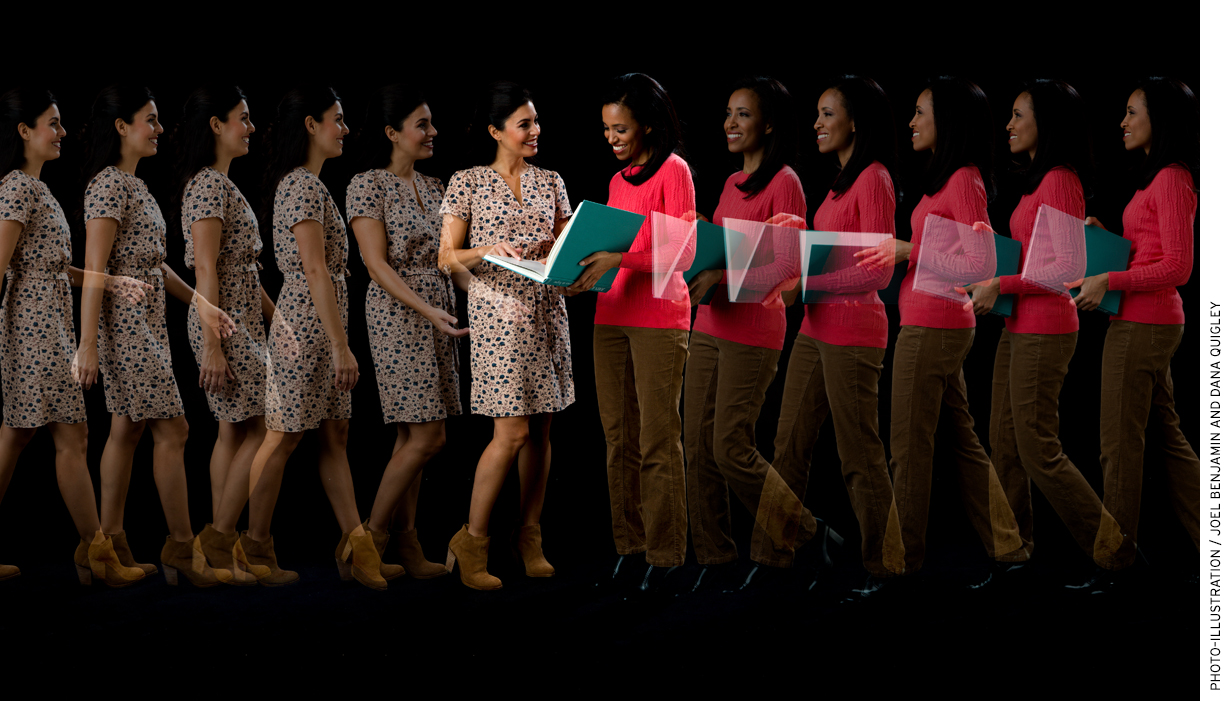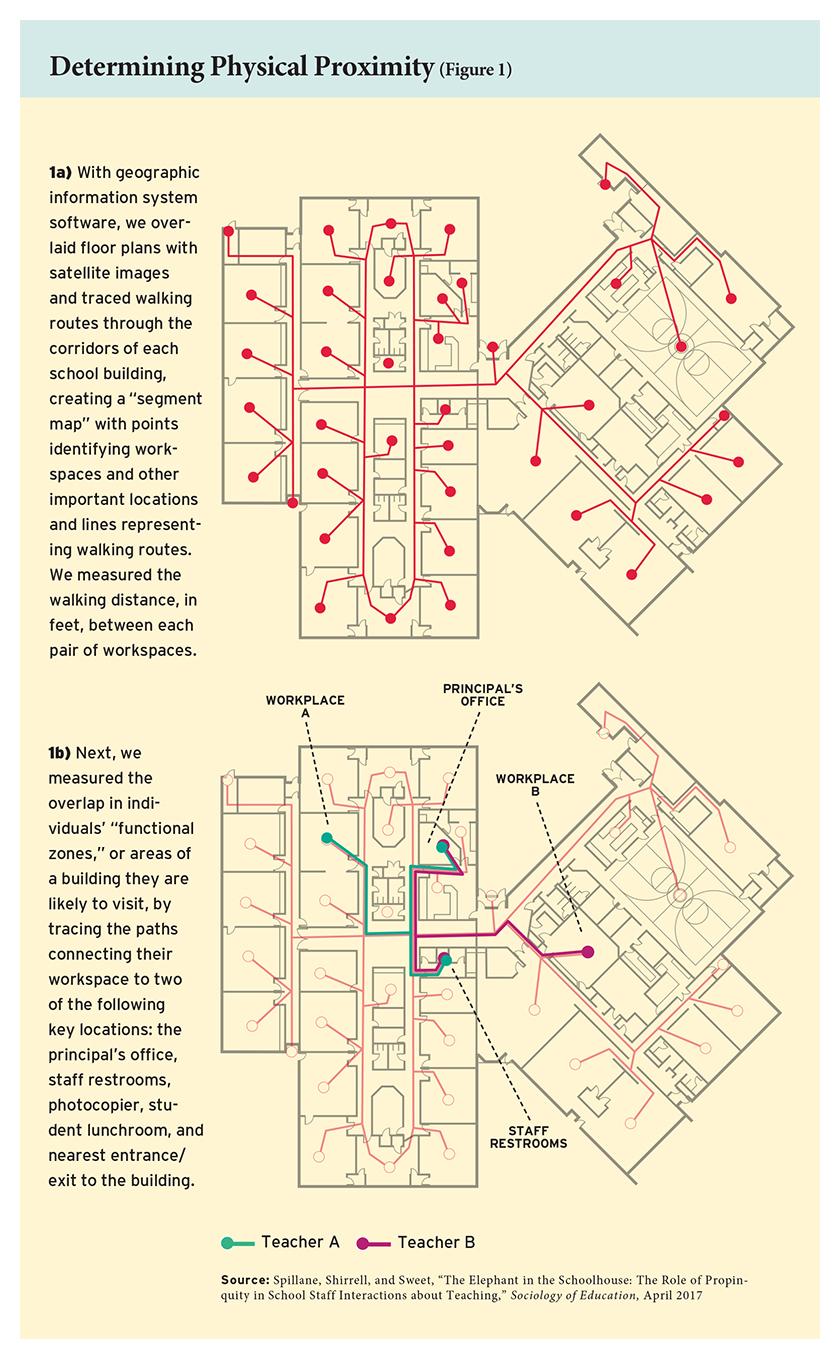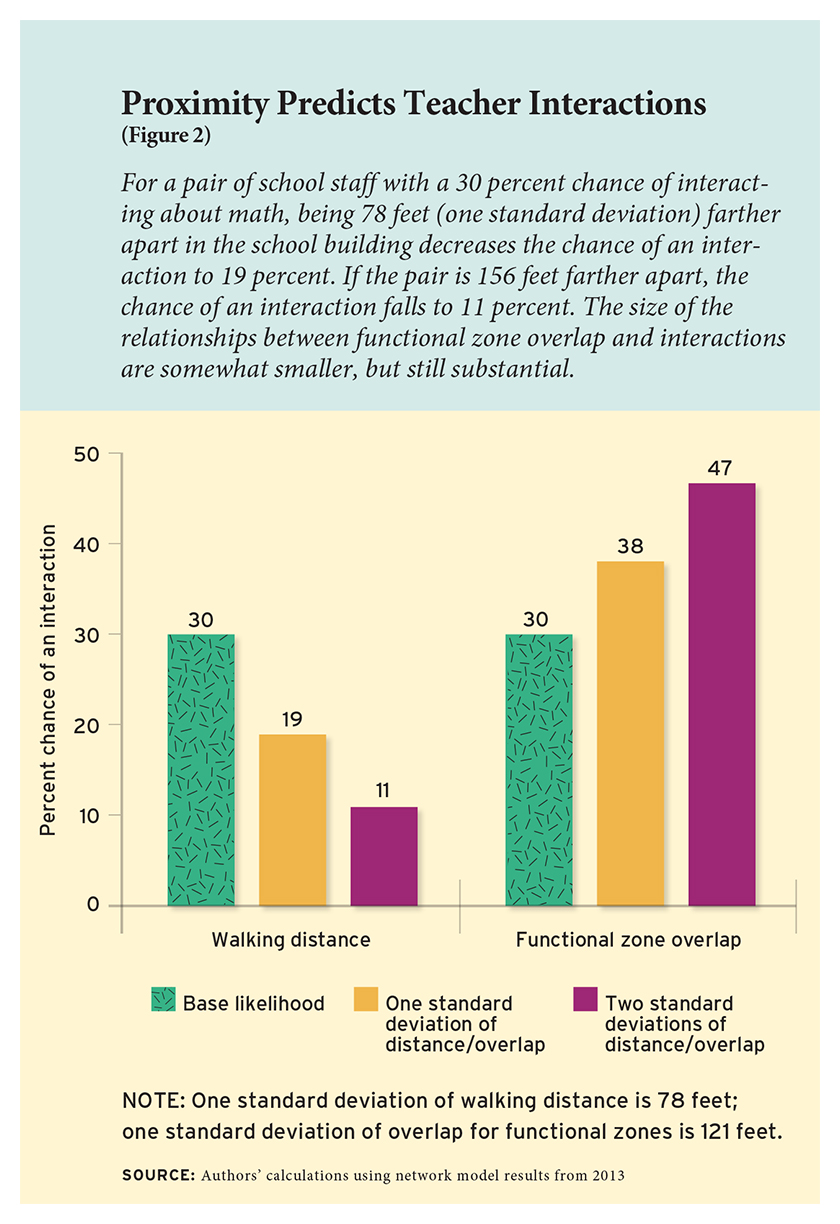
The work of teaching is changing. For much of the 20th century, most teachers worked alone behind classroom doors, with little interaction with their colleagues. In recent years, however, teacher collaboration has emerged as an important strategy to drive improvement, informed by research showing how on-the-job interactions can boost teacher development and effectiveness. Schools across the United States are adjusting their professional cultures and workplace practices in response, creating formal opportunities for teachers to learn from one another and work together through shared planning periods, teacher leadership roles, and professional learning communities.
Despite these changes, one constant often remains: legacy school buildings that follow an “egg crate” or cellular design, in which long hallways are lined with nearly identical, self-contained classrooms. This type of building, created to promote efficiencies and separate students into age-based groups to receive direct instruction by a single teacher, was not designed with adult collaboration in mind. It is also where the vast majority of public school teachers will work for the foreseeable future. Given what we know about the importance of bringing teachers together, how does the physical infrastructure of a conventional egg crate school influence their interactions with colleagues?
We spent four years studying a midwestern suburban district, interviewing staff and analyzing building plans and survey data to explore this question. Our analysis finds that physical proximity predicts staff interactions, with teachers and school leaders more likely to interact about instruction with colleagues who are located physically close to them or with whom they are likely to cross paths during the school day. In addition, teachers and administrators often reference physical proximity in describing why and how they interact with one another, with chance encounters due to proximity serving as a supplement to more formal collaboration.
Given these findings, schools and school districts should think carefully about where they assign school staff to workspaces, no matter their design. Our study suggests that even in an egg crate building, teachers are more likely to share their insights with one another if they are nearby.
Tracking Teachers’ Interactions
Our study includes all 14 elementary schools in an unnamed midwestern suburban school district that serves approximately 6,000 elementary school students. One in four students qualifies for subsidized school meals; 82 percent are white, 6 percent are Latino, and 5 percent are African American. All 14 school buildings are of the conventional egg crate design. We employed several methods in our data collection: interviews with a small, carefully selected sample of staff members from five schools, four years of survey data from all instructional staff at all 14 elementary schools, and school-building plans and geographic information.
To explore staff members’ thinking about how physical proximity impacted their interactions with colleagues, we collected and analyzed interviews from a purposeful sample of 33 school staff in five schools during the 2010–11 school year. We intentionally chose schools that varied in their student demographics, particularly with respect to the shares of students who were English language learners or from low-income families. Within those schools, we selected staff members who held a variety of formal positions, such as principal, teacher leader, and teacher, and who occupied different positions in their schools’ mathematics advice and information networks, such as being highly or weakly connected.
 The semi-structured interviews focused on whom individuals interacted with about math instruction, and how and why they interacted with those individuals. The interview protocol did not include questions about physical proximity; however, without prompting, 27 of the 33 interviewees mentioned physical proximity as a reason for interacting with a peer about math. To analyze these observations, we extracted the portions of the interview transcripts where interviewees discussed physical proximity, and coded these transcripts both deductively and inductively.
The semi-structured interviews focused on whom individuals interacted with about math instruction, and how and why they interacted with those individuals. The interview protocol did not include questions about physical proximity; however, without prompting, 27 of the 33 interviewees mentioned physical proximity as a reason for interacting with a peer about math. To analyze these observations, we extracted the portions of the interview transcripts where interviewees discussed physical proximity, and coded these transcripts both deductively and inductively.
We also surveyed all instructional staff in the 14 elementary schools in the spring of 2010, 2011, 2012, and 2013, with schools’ response rates between 81 percent and 95 percent. The survey asked staff about their perceptions of their schools, their backgrounds, and their work-related interactions. Staff members were asked to list the colleagues they turned to for advice or information about their work during the prior year, and name the school subjects under discussion and the frequency of interactions. Respondents also provided the room numbers of the classrooms where they worked. While the survey included questions about a number of school subjects, we focus on math advice and information networks here. Our results were similar across subjects.
We then studied architectural floor plans of all 14 schools to determine staff members’ physical proximity to one another. With geographic information system (GIS) software, we overlaid floor plans with satellite images and traced walking routes through the corridors of each school building. This resulted in a “segment map” of each school building, with the points demarcating workspaces or other important locations and the lines representing the walking routes throughout the building’s corridors (see Figure 1). Then we calculated two measures of physical proximity: the walking distance, in feet, between every instructional staff member in the building; and the overlap of individuals’ “functional zones,” or areas of a building they are likely to visit. We determined “functional zones” for each staff member by tracing the paths connecting their workspace to two of these locations: the principal’s office, staff restrooms, photocopier, student lunchroom, and nearest entrance/exit to the building.
Using this data, we analyzed each school’s math network to examine whether the physical proximity of pairs of staff, based on their reported room numbers, predicted an interaction between them about math, after controlling for factors prior research has shown predict such relationships.
Insights from Interviews
Our analysis of interview data examined the explanations school staff offered when they identified—unprompted—physical proximity as a reason for interacting with a colleague. We noticed two broad themes: proximity not only made it easier to purposefully interact with colleagues, but also increased opportunities for chance encounters.
First, proximity reduced the cost or effort of interacting with colleagues. One fifth-grade teacher referenced a door connecting her classroom with another in explaining why she regularly spoke with one colleague: “because we’re next door to each other . . . because we have that connecting door it’s just easier than [going] across the hall.” Proximity enabled that work-related interaction by reducing the effort involved, even when the differences in distance were small.
Similarly, a kindergarten teacher, in explaining why she interacted with one fellow kindergarten teacher but not others, said:
I’m right next door to one of my [colleagues], our kindergarten team is kinda spread out but I’m right next door to [teacher] and she teaches kindergarten. She’s amazing at math too. [laughs] And so she’s a given that I always, I always go to her first . . . it’s kinda easy to be like, “OK, so my kids are doing this today in math.”
Second, respondents detailed how proximity created opportunities for chance encounters. “It’s casual it’s just, you see them . . . because it’s more like in passing . . . hallways,” one sixth-grade teacher said.
A first-grade teacher noted the difference between formal and informal encounters. Formally organized meetings with colleagues teaching the same grade were important in supporting interactions about teaching, she said, but proximity was critical to engage in unplanned exchanges with her colleagues:
Just before each unit we [other teachers in her grade level] sit down and we talk about what, what are the objectives, what do the students have to learn, what activities can we do to ensure . . . success of all that . . . we were doing a graphing activity and the students graphed and we [other teachers in her grade level] were discussing the graph out in the hallway and um, she happened to walk by and she just kind of sat down and joined us and so then I just asked her . . . some feedback on, you know, how my conversation went and what I could have [done] to . . . deepen the kids’ understanding.
Our analysis also suggests that interacting about teaching with nearby colleagues supplemented more formal interactions. One first-grade teacher compared grade-level and subject team meetings to unplanned encounters thus:
We do that as we plan, but yet we’re always constantly, we, on a day-to-day basis I feel like we almost talk, “How did that go in math?” or, “I did this and this worked great.” And so we’re always just sharing ideas.
Social Network Analysis
To examine whether physical proximity predicted staff interactions, we conducted a social network analysis across all 14 school buildings. We found that physical proximity, whether measured as within-building walking distances or as the overlap of staff members’ “functional zones,” predicted work-related interactions among staff.
 Across all four years of our study, we found that as the walking distance between the workspaces of a pair of staff members increased, the likelihood of a math tie between those individuals decreased. We also found that the greater the overlap of two individuals’ “functional zones,” the more likely they were to interact with one another about math. These associations were statistically significant even after we controlled for the strongest predictors of on-the-job peer interactions found by prior research: teaching multiple grades, having a leadership position, the number of years of experience, teaching the same grade, and network size.
Across all four years of our study, we found that as the walking distance between the workspaces of a pair of staff members increased, the likelihood of a math tie between those individuals decreased. We also found that the greater the overlap of two individuals’ “functional zones,” the more likely they were to interact with one another about math. These associations were statistically significant even after we controlled for the strongest predictors of on-the-job peer interactions found by prior research: teaching multiple grades, having a leadership position, the number of years of experience, teaching the same grade, and network size.
The magnitude of the associations we found between physical proximity and interactions suggests that proximity is strongly associated with the likelihood of talking with a colleague about math instruction. If a pair of school staff had a 30 percent chance of interacting about math, for example, our results show that if we moved those individuals 78 feet farther apart in the school building (or one standard deviation of distance), their likelihood of an interaction would decrease to 19 percent (see Figure 2). If we moved the pair two standard deviations of distance apart, or 156 feet, the likelihood would drop to 11 percent.
The magnitudes of the associations between functional zone overlap and math interactions were somewhat smaller than they were for walking distance, although still statistically distinguishable from zero. This suggests that walking distance is a stronger predictor of math interactions than functional zone overlap. Overall, however, our analyses found that although other factors—particularly teaching the same grade—are more strongly associated with interacting with a colleague than proximity, being physically close to one another in the school workplace still has a substantial association with the likelihood that staff will talk to each other about their work.
These findings raise the question of whether proximity predicts interactions, or whether interactions predict proximity. It’s possible that school staff who already had interacted with one another were assigned workspaces close to one another, and separating cause and effect with our repeated cross sections of social network data is difficult.
To address this challenge, we conducted a number of exploratory analyses, with four findings. First, we found relatively small changes in proximity between pairs of instructional staff members from year to year. Looking at the change from 2010 and 2011, half of staff pairs had no change in distance. From 2011 to 2012, 62 percent had no change, and from 2012 to 2013, 59 percent had no change. Further, most of the changes that did occur were distances of less than 50 feet. Second, we found that whether or not two staff members had interacted the prior year did not predict the pair moving closer to one another the following year. Third, we found the same relationship between proximity and interactions for pairs that included at least one staff member who was entirely new to the field of education, and where prior ties between pairs were therefore unlikely to have determined proximity. Fourth, we found the same general pattern of results when controlling for whether pairs had an interaction the prior year, showing that proximity predicted the formation of new ties, not just those that existed previously. Although not definitive—and we caution against interpreting our findings causally—our results suggest that proximity predicts instructional interactions, not the reverse.
Implications
For too long, our field has ignored how the physical infrastructure of schools influences school staff interactions about instruction. Although only a first step, our findings demonstrate the need for a greater understanding of how staff proximity within school buildings can enable and constrain collaboration, and how relatively small distances can make a big difference in whether teachers interact with one another.
Our informal discussions with school leaders suggest that staff are most often assigned to workspaces out of convenience, with coaches assigned to empty offices and teachers clustered roughly with those who teach similar grade levels. We believe that decisions about assigning teachers and other school
staff to workspaces should be deliberate, with leaders explicitly taking into account the important role of physical proximity to influence who will be talking to whom about teaching
and learning.
Physically placing master teachers, highly effective teachers, or coaches in central locations where they are closer to—and more likely to cross paths with—their colleagues would increase the probability that these individuals interact with and influence others. School leaders also could place lower-performing or inexperienced teachers close to high performers, or place staff with complementary strengths and weaknesses in closer proximity.
Even within conventional egg crate school buildings, such intentional location scouting could influence the flow of information about instruction. Creating strong cultures with shared high standards and proven best practices is critical to the development of new instructional knowledge. Although far from a magic bullet, our analysis suggests that intentionally assigning staff to workspaces is a relatively straightforward and cost-effective way to promote interaction and collaboration, to the benefit of students.
James P. Spillane is the Spencer T. and Ann W. Olin Professor in Learning and Organizational Change at Northwestern University. Matthew Shirrell is an assistant professor of educational leadership and administration at George Washington University. A more detailed account of this investigation can be found in the April 2017 issue of Sociology of Education.
This article appeared in the Spring 2018 issue of Education Next. Suggested citation format:
Spillane, J.P., and Shirrell, M. (2018). The Schoolhouse Network: How school buildings affect teacher collaboration. Education Next, 18(2), 68-73.


